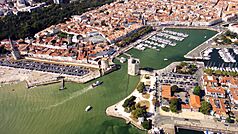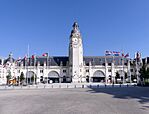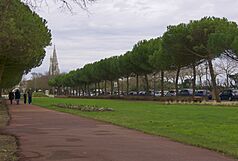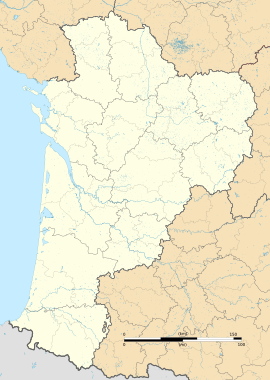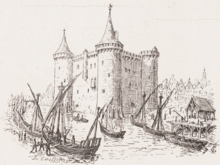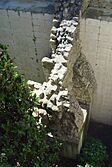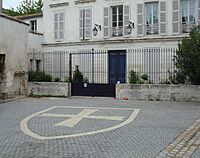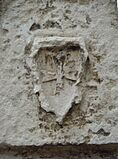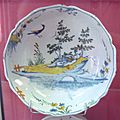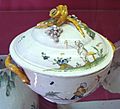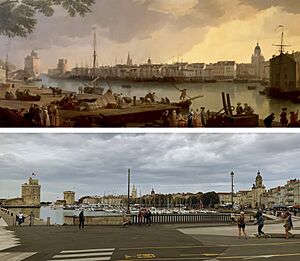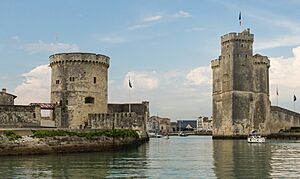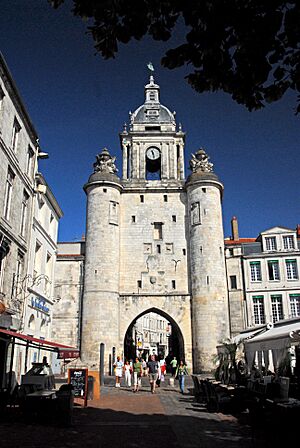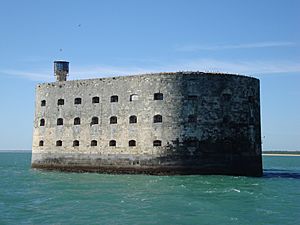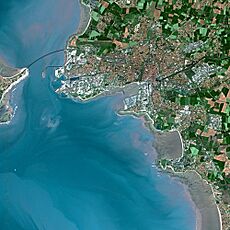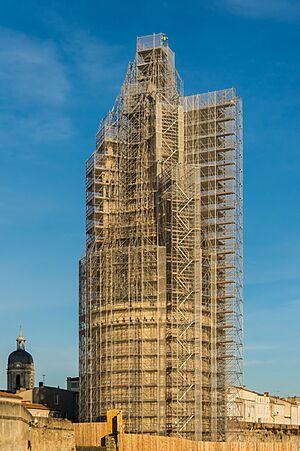La Rochelle facts for kids
Quick facts for kids
La Rochelle
La Rochéle (Poitevin–Saintongeais)
|
||
|---|---|---|
|
Prefecture and commune
|
||
|
|
||
|
||
| Country | France | |
| Region | Nouvelle-Aquitaine | |
| Department | Charente-Maritime | |
| Arrondissement | La Rochelle | |
| Intercommunality | CA La Rochelle | |
| Area
1
|
28.43 km2 (10.98 sq mi) | |
| Population
(2021)
|
78,535 | |
| • Density | 2,762.4/km2 (7,154.6/sq mi) | |
| Time zone | UTC+01:00 (CET) | |
| • Summer (DST) | UTC+02:00 (CEST) | |
| INSEE/Postal code |
17300 /17000
|
|
| Elevation | 0–28 m (0–92 ft) (avg. 4 m or 13 ft) |
|
| 1 French Land Register data, which excludes lakes, ponds, glaciers > 1 km2 (0.386 sq mi or 247 acres) and river estuaries. | ||
La Rochelle is a lively city on the west coast of France. It's a major seaport located on the Bay of Biscay, which is part of the Atlantic Ocean. This city is the capital of the Charente-Maritime area.
In 2021, La Rochelle had about 78,535 people living there. This makes it the most populated city in its department. It's also the fourth largest city in the Nouvelle-Aquitaine region, after Bordeaux, Limoges, and Poitiers.
The city is right on the edge of the Atlantic Ocean. It's connected to the Île de Ré island by a long bridge. This bridge is about 2.9 kilometers (1.8 miles) long and was finished in 1988. Since the Middle Ages, La Rochelle's harbor has been a safe place for ships. It's known as a "gateway to the ocean" because it has three important ports: one for fishing, one for trade, and one for yachts. The city has always been a busy trading hub.
La Rochelle has a rich history, going all the way back to Roman times. You can still see old buildings like the Saint Nicolas Tower. It's the most important coastal city between the Loire and Gironde rivers. La Rochelle is a busy place with many different activities. It's still an important port and industrial city. But it also has a strong focus on services, with a university and a growing tourism industry. It's often ranked as one of the best cities to live in France.
Contents
History of La Rochelle
La Rochelle has a long and interesting past. Let's explore some key moments in its history.
Ancient Times
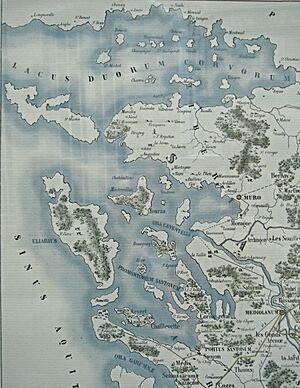
The Romans lived in this area a long time ago. They were good at making salt along the coast. Signs of Roman homes and salt farms have been found here.
How La Rochelle Began
The name "La Rochelle" first appeared in records in 961. It came from a Latin word meaning "little rock." The city became a harbor after a duke named Guillaume X won a battle in 1130. He destroyed another harbor nearby and made La Rochelle a free port in 1137. This meant ships could come and go without paying many taxes.
Fifty years later, Eleanor of Aquitaine supported La Rochelle's special rights. For the first time in France, La Rochelle got its own city mayor, Guillaume de Montmirail. He worked with 24 city leaders and 75 nobles to govern the people.
English Rule (1154–1224)
Eleanor of Aquitaine married Henry II, who became the King of England. This meant La Rochelle was ruled by England for a while. In 1185, Henry II built the Vauclair castle here. You can still see parts of it today.
During this time, La Rochelle was busy with trade. Ships carried goods like wine and other products to England, the Netherlands, and Spain.
The Knights Templar
The Knights Templar were a powerful group of knights. They had a strong presence in La Rochelle. It was their biggest base on the Atlantic Ocean. They used La Rochelle to help trade between England and the Mediterranean Sea. Some stories say that the Templars used their ships in La Rochelle to escape arrest in 1307.
Hundred Years' War
La Rochelle became part of the French royal lands in 1271. During the Hundred Years' War, the city was again under English rule in 1360. But in 1372, La Rochelle's people drove out the English. This happened after a big naval battle near the city. French and Spanish ships defeated the English fleet. This battle was one of the first times that handguns were used on warships.
After gaining freedom, La Rochelle made sure King Charles V respected their city's special rights. Until the 1400s, La Rochelle was the biggest French harbor on the Atlantic coast. It mainly traded in wine, salt, and cheese.
French Wars of Religion
Right image: Remains of iconoclasm, Eglise Saint-Sauveur, La Rochelle.
During the Renaissance, many people in La Rochelle became Protestants. This was part of the Reformation. The city became a center for the Huguenots, who were French Protestants. In 1568, La Rochelle declared itself an independent Protestant republic, like the city of Geneva. This led to many fights with the Catholic government of France.
Protestants in La Rochelle destroyed religious images in churches in 1560 and 1562. They even killed some Catholic priests.
The city was then attacked during the siege of La Rochelle (1572–1573). This happened after the St. Bartholomew's Day massacre, where many Protestants were killed. The conflict ended with a peace treaty in 1573. This treaty allowed Protestants to worship only in a few cities, including La Rochelle.
Huguenot Rebellions
Under King Louis XIII, La Rochelle had some freedom. But in 1622, the city revolted. A fleet from La Rochelle fought the royal navy but was defeated.
The Great Siege (1627–1628)

The most famous event in La Rochelle's history is the Siege of La Rochelle. King Louis XIII and his chief minister, Cardinal Richelieu, decided to stop the Protestant revolts. England tried to help La Rochelle by sending an army. But this effort failed.
Richelieu then blocked the city for 14 months. No supplies could get in or out. The people of La Rochelle suffered greatly. Finally, the city surrendered. It lost its mayor and its special rights.
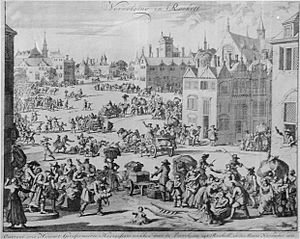
After the siege, Protestants in La Rochelle faced more difficulties. Many were forced to leave the city. In 1685, King Louis XIV took away the rights of Protestants across France. Many Huguenots left France entirely. Some even founded a new city called New Rochelle near New York in America. The siege of La Rochelle is a big part of the story in the famous book, The Three Musketeers.
La Rochelle and the New World

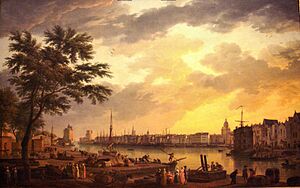
Because La Rochelle is on the western coast, it was a great starting point for voyages to the New World. This helped the city's trade. After the Wars of Religion, La Rochelle became very rich. Its shipowners were active in the triangular trade. This involved trading enslaved people from Africa, sugar from the West Indies, and furs from Canada.
Many French settlers also left from La Rochelle to go to New France (Canada). For example, in 1665, about 1,200 soldiers left La Rochelle to help protect Quebec. Also, many young women known as the Filles du Roi (Daughters of the King) sailed from here to Quebec between 1663 and 1673.
The explorer Robert de La Salle also left La Rochelle in 1684. He aimed to start a colony at the mouth of the Mississippi River.
La Rochelle's trade declined during the 1700s and early 1800s. France lost many of its lands in the New World. The city's role as a major harbor became smaller. The slave trade from La Rochelle ended around the 1790s.
La Rochelle Faience
La Rochelle became famous for its faience (a type of pottery) in the late 1700s. The style was often inspired by Chinese and Japanese designs. You can see many of these beautiful ceramics at the Musée d'Orbigny-Bernon.
Second World War
During World War II, Germany built a large submarine base at La Pallice, which is La Rochelle's main port.
La Rochelle was one of the last French cities to be freed at the end of the war. German troops held the city until May 1945. The submarine base was used as a filming location for the movie Das Boot and scenes in Raiders of the Lost Ark.
La Rochelle Today
La Rochelle still has a busy deep-water harbor called La Pallice. The huge submarine pens from World War II are still there, but they are not used. La Pallice handles oil and tropical wood. The city's fishing boats also use this port.
La Rochelle has a very large aquarium and a small botanical garden. The Calypso, the famous ship used by Jacques-Yves Cousteau for ocean research, is now on display at the Maritime Museum of La Rochelle.
Culture and Festivals
La Rochelle hosts the Festival de la Fiction, a film festival that shows new movies. It also hosts one of France's biggest music festivals, Les Francofolies de La Rochelle. This festival happens every summer and brings together French-speaking musicians for a week of concerts.
Tourism
The main attraction in La Rochelle is the "Vieux Port" or "Old Harbor." It's a beautiful place with many seafood restaurants. You can walk along the old city walls in the evening. The old town is very well preserved.
Three medieval towers stand at the entrance to the harbor: The Chain Tower, The Lantern Tower, and Saint Nicolas Tower. You can take boat trips from the harbor to nearby islands like Île d'Aix and to Fort Boyard. The nearby Île de Ré island is just a short drive away.
Transport
La Rochelle has an international airport, La Rochelle - Île de Ré Airport. The main train station, Gare de La Rochelle, connects the city to other major French cities like Bordeaux, Nantes, and Paris.
La Rochelle was one of the first cities to have a successful bicycle sharing system, starting in 1974.
Education
La Rochelle is home to the University of La Rochelle, which was founded in 1993. There is also the Excelia Group (La Rochelle Business School). More than 10,000 students study in La Rochelle each year.
Les Minimes
Les Minimes is a large marina in La Rochelle. It's considered the city's new port and can hold about 5,000 boats. This area also has university campuses for students. It has shops, restaurants, a cinema, and other facilities. The port is one of the biggest in Europe.
Geography
Geology
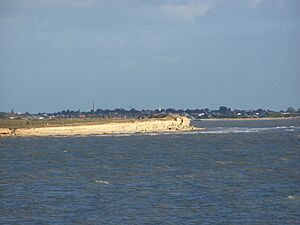
The ground under La Rochelle is made of limestone layers. These rocks are about 160 million years old, from the Jurassic period. At that time, much of France was under water. You can see these white cliffs along the sea. They contain small sea fossils. This limestone is often used as a building material in the region.
Climate
La Rochelle has an oceanic climate. This means it has mild weather all year round. The Gulf Stream ocean current helps keep the temperatures moderate. Summers are usually warm and sunny. Winters are mild and wet. La Rochelle gets a lot of sunshine, more than many other places in Western France.
| Climate data for La Rochelle, France (1981–2010 averages, extremes 1955–present) | |||||||||||||
|---|---|---|---|---|---|---|---|---|---|---|---|---|---|
| Month | Jan | Feb | Mar | Apr | May | Jun | Jul | Aug | Sep | Oct | Nov | Dec | Year |
| Record high °C (°F) | 16.3 (61.3) |
21.2 (70.2) |
25.0 (77.0) |
29.1 (84.4) |
33.6 (92.5) |
40.5 (104.9) |
39.0 (102.2) |
38.2 (100.8) |
34.6 (94.3) |
30.1 (86.2) |
22.2 (72.0) |
18.7 (65.7) |
40.5 (104.9) |
| Mean daily maximum °C (°F) | 9.1 (48.4) |
10.2 (50.4) |
13.0 (55.4) |
15.5 (59.9) |
19.1 (66.4) |
22.3 (72.1) |
24.4 (75.9) |
24.5 (76.1) |
22.1 (71.8) |
18.1 (64.6) |
13.0 (55.4) |
9.7 (49.5) |
16.8 (62.2) |
| Daily mean °C (°F) | 6.6 (43.9) |
7.1 (44.8) |
9.6 (49.3) |
11.8 (53.2) |
15.4 (59.7) |
18.5 (65.3) |
20.5 (68.9) |
20.5 (68.9) |
18.1 (64.6) |
14.7 (58.5) |
10.0 (50.0) |
7.1 (44.8) |
13.4 (56.1) |
| Mean daily minimum °C (°F) | 4.0 (39.2) |
4.1 (39.4) |
6.3 (43.3) |
8.1 (46.6) |
11.7 (53.1) |
14.6 (58.3) |
16.7 (62.1) |
16.5 (61.7) |
14.0 (57.2) |
11.3 (52.3) |
7.1 (44.8) |
4.5 (40.1) |
9.9 (49.8) |
| Record low °C (°F) | −11.5 (11.3) |
−13.6 (7.5) |
−6.6 (20.1) |
−1.2 (29.8) |
1.9 (35.4) |
4.9 (40.8) |
8.1 (46.6) |
8.8 (47.8) |
5.4 (41.7) |
−0.4 (31.3) |
−5.4 (22.3) |
−9.5 (14.9) |
−13.6 (7.5) |
| Average precipitation mm (inches) | 74.0 (2.91) |
56.8 (2.24) |
53.9 (2.12) |
64.9 (2.56) |
55.8 (2.20) |
39.1 (1.54) |
43.9 (1.73) |
45.0 (1.77) |
60.3 (2.37) |
91.9 (3.62) |
93.5 (3.68) |
87.9 (3.46) |
767.0 (30.20) |
| Average precipitation days (≥ 1.0 mm) | 11.9 | 9.1 | 9.7 | 10.3 | 9.3 | 6.7 | 6.6 | 6.3 | 7.4 | 11.9 | 12.4 | 12.5 | 114.1 |
| Average snowy days | 1.0 | 0.9 | 0.5 | 0.2 | 0.0 | 0.0 | 0.0 | 0.0 | 0.0 | 0.0 | 0.2 | 0.9 | 3.7 |
| Average relative humidity (%) | 87 | 84 | 80 | 78 | 79 | 77 | 76 | 77 | 79 | 83 | 86 | 88 | 81.2 |
| Mean monthly sunshine hours | 84.3 | 114.6 | 165.8 | 196.8 | 231.3 | 261.2 | 271.0 | 259.6 | 212.1 | 140.5 | 92.3 | 76.3 | 2,105.5 |
| Source 1: Meteo France | |||||||||||||
| Source 2: Infoclimat.fr (humidity and snowy days 1961–1990) | |||||||||||||
Population of La Rochelle
The people who live in La Rochelle are called "les Rochelaises" (for girls and women) and "les Rochelais" (for boys and men). The city's population has changed over time.
| Historical population | |||||||||||||||||||||||||||||||||||||||||||||||||||||||||||||||||||||||||||||||||||||||||||||||||||||||||||||||||||
|---|---|---|---|---|---|---|---|---|---|---|---|---|---|---|---|---|---|---|---|---|---|---|---|---|---|---|---|---|---|---|---|---|---|---|---|---|---|---|---|---|---|---|---|---|---|---|---|---|---|---|---|---|---|---|---|---|---|---|---|---|---|---|---|---|---|---|---|---|---|---|---|---|---|---|---|---|---|---|---|---|---|---|---|---|---|---|---|---|---|---|---|---|---|---|---|---|---|---|---|---|---|---|---|---|---|---|---|---|---|---|---|---|---|---|---|
|
|
||||||||||||||||||||||||||||||||||||||||||||||||||||||||||||||||||||||||||||||||||||||||||||||||||||||||||||||||||
| Source: EHESS and INSEE (1968-2017) | |||||||||||||||||||||||||||||||||||||||||||||||||||||||||||||||||||||||||||||||||||||||||||||||||||||||||||||||||||
Famous Landmarks
- Orbigny-Bernon Museum
- Muséum d'histoire naturelle de La Rochelle (Natural History Museum)
- Saint-Louis Cathedral
Notable People from La Rochelle
Many interesting people were born in or lived in La Rochelle:
- Antoine Albeau, a famous windsurfer.
- Gabrielle-Suzanne Barbot de Villeneuve, who wrote the original story of Beauty and the Beast.
- William-Adolphe Bouguereau, a well-known painter.
- Jean-Loup Chrétien, an astronaut.
- Jean Guiton, the mayor during the famous siege of La Rochelle.
- Guy Laroche, a fashion designer.
- René-Antoine Ferchault de Réaumur, a scientist.
- Jean-Paul Sartre, a famous philosopher and novelist who lived here.
- Georges Simenon, a well-known author who also lived in the city.
Sports in La Rochelle
Stade Rochelais is a professional rugby union team. They play in the top French league, Top 14. Their home games are at Stade Marcel-Deflandre.
Since 1991, La Rochelle has hosted the Marathon de La Rochelle every year. It's the second most popular marathon in France.
Stade Rochelais Basket is the local basketball team. In 2022, they moved up to the LNB Pro B league.
Sister Cities
La Rochelle has special connections with other cities around the world. These are called "twin towns" or "sister cities":
 New Rochelle, New York, United States (since 1910)
New Rochelle, New York, United States (since 1910) Acre, Israel (since 1972)
Acre, Israel (since 1972) Petrozavodsk, Karelia, Russia (since 1973)
Petrozavodsk, Karelia, Russia (since 1973) Lübeck, Schleswig-Holstein, Germany (since 1988)
Lübeck, Schleswig-Holstein, Germany (since 1988) Essaouira, Morocco (since 1999)
Essaouira, Morocco (since 1999) Santiago de Figueiró, Portugal (since 2003)
Santiago de Figueiró, Portugal (since 2003)
See also
 In Spanish: La Rochelle para niños
In Spanish: La Rochelle para niños


